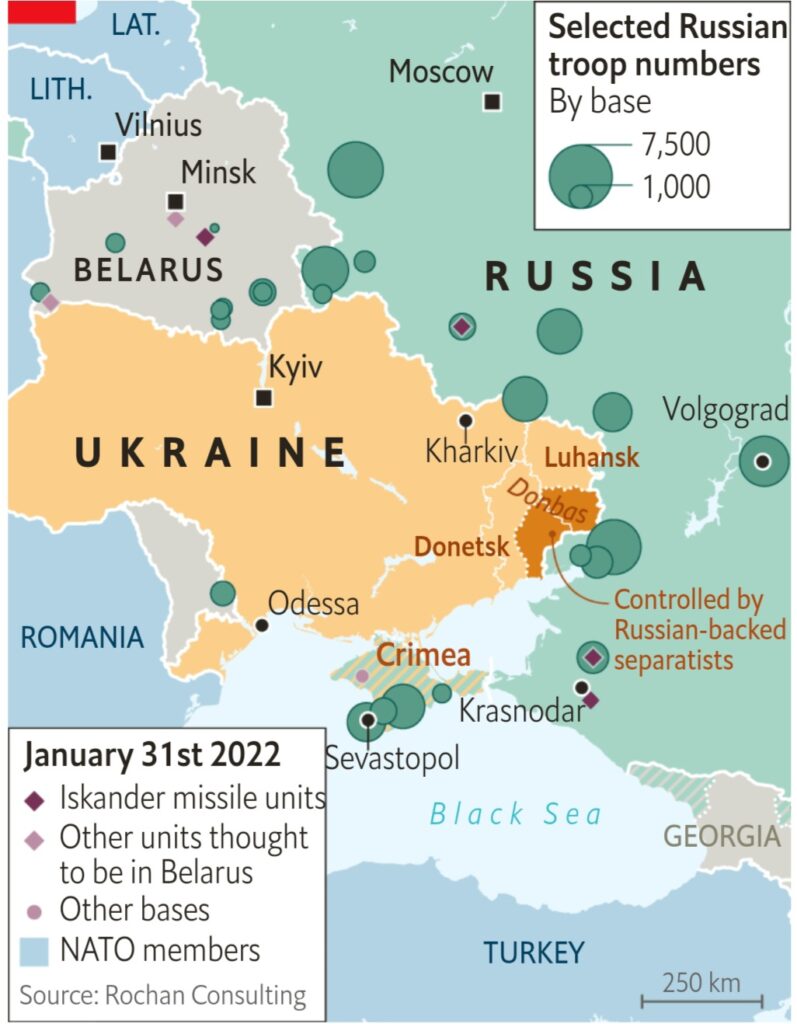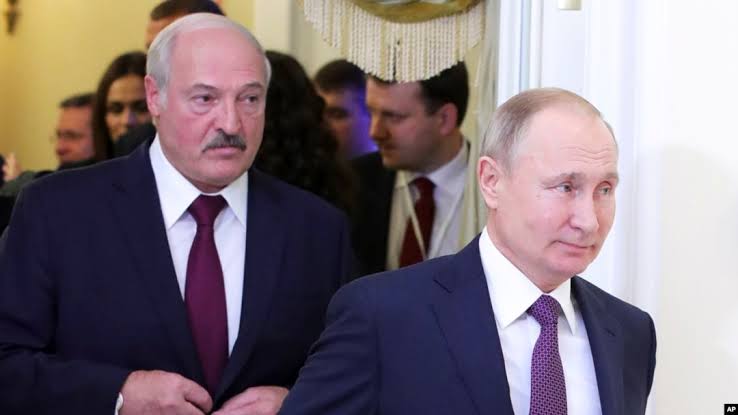•It is the biggest concentration of firepower in Europe since the cold war
By The Economist
The crisis on the Russia-Ukraine border shows no sign of easing. On January 27th Joe Biden, America’s president, told Volodymyr Zelensky, his Ukrainian counterpart, that a Russian invasion of Ukraine in February was a “distinct possibility”. On January 31st Russia jousted with America in a special session of the un Security Council. Russian social media is abuzz with videos of troops on the move by rail and road. But how large and unusual is the build-up?
To grasp its scale, it is necessary to understand the currency of modern Russian deployments: the battalion tactical group, or btg, a fighting formation of 600 to 1,000 troops equipped with their own artillery, air defence and logistics. During the worst fighting of the Russia-Ukraine war, in 2015, Russia sent no more than a dozen btgs. Today it has 74 to 76 deployed to the border areas, according to Konrad Muzyka of Rochan Consulting, who tracks Russian military movements. Around a fifth of those are in Belarus; on January 30th an American official said that “up to 30,000” troops were being sent there.
In total, says Mr Muzyka, elements of ten out of the country’s eleven Combined Arms Armies—a high-level formation that typically contains several divisions—are now near Ukraine. The btg-count excludes air and naval forces, as well as vdv units, or paratroopers, who are now available after a brief jaunt in Kazakhstan earlier this month. Add them all up, and Russia may have more than 130,000 troops in place.
That is not yet at the scale of the very largest mobilisations of the cold war. When the Soviet Union and its Warsaw Pact allies invaded Czechoslovakia in 1968, they sent in a quarter of a million troops, with ten more divisions in the rear. But it is not far off the biggest Soviet exercise ever held during the cold war, “Zapad-81” in 1981, which involved as many as 150,000 troops, and it has surpassed the biggest nato exercise, “Reforger” in 1988, which gathered 125,000. Russia’s build-up today is also larger than America’s in Europe ahead of the first Gulf war in 1991 or the nato air campaign against Serbia in 1999. It far surpasses the first and second Chechen wars, which began in 1994 and 1999 respectively, each of which involved fewer than 50,000 Russian troops.
In raw numbers, the last mobilisation of this size was Operation Storm, a Croatian offensive against Serbia in 1995, during the Balkan wars, in which as many as 130,000 Croatian troops were thrown into action. Yet Russia’s armed forces are better armed and equipped than those Croatian ones, with considerably more capable air and missile forces at their disposal. In other words, this is probably the largest accretion of firepower seen in Europe for 40 years.
Nor is it confined to land. On January 20th Russia’s defence ministry announced that all four of its naval fleets—the Baltic, Black Sea, Northern and Pacific Fleets—would hold drills in January and February involving more than 140 warships and support vessels and 10,000 personnel, including missile launches off Ireland’s west coast. Warships from Russia’s Baltic and Northern Fleets are already streaming towards the Black Sea, including landing craft that could enable an amphibious assault or raids on Ukrainian ports. Key ships from the Pacific Fleet are headed for the Mediterranean. Some ships are even being moved south overland—including Vladimir Putin’s presidential boat.
The most worrying aspect of the build-up, though, may be the least eye-catching of all. Military planners divide combat forces into “teeth” (crudely, things with guns) and “tail” (the things that support them). Soldiers and tanks are of no use if they cannot be kept fuelled, armed and on the move. Petri Mäkelä, a Finnish military analyst, points to examples of several such enablers being prepared or moved, including many that are usually controlled by high-level formations and rarely deployed to exercises. These include long-range radar sets, radio relay systems and spare missiles for offensive launchers and air-defence systems.

Engineering, logistics and medical enablers have also been spotted. Russian “pipeline troops”, which rapidly refuel mechanised forces, and can lay up to 80km of pipeline a day, have been seen in Krasnodar, close to Crimea. American officials have also said that Russia has moved blood supplies closer to the Ukrainian border, according to both Reuters and cnn. There are also signs that Russian combat forces are limbering up in other ways. “I think we are starting to see signs that they are moving into smaller locations near the Ukrainian border,” says Dara Massicot of the rand Corporation, a think-tank. “That is generally not great. Once units deploy like that it is usually one of the final signposts.”
Not everything is in place just yet. Many of the deployed units are under-strength, though troops could be flown in within three days. Janes, a defence-intelligence firm, says that the “final indicators” of an offensive would probably include the activation of paratroopers, transport planes to move troops and the large-scale movement of warplanes to air bases near the border (some have begun moving). If it were serious about a big offensive, Russia would also be expected to mobilise reserves on a large scale, as well as forces from omon, a gendarmerie-type unit, and other paramilitary forces, to generate the manpower necessary to hold any ground it captured.
Even so, the notion that Russia’s build-up might be nothing more than a “simple rotation”, as Mr Zelensky, Ukraine’s president, suggested on January 28th, is preposterous. Perhaps most striking is that Russia has activated units from every corner of its territory. Even the Eastern Military District, an administrative zone that stretches to the North Korean border, has been virtually emptied out, with most of its forces sent to Belarus. “Not since 1922 have there been so few forces on the border with Mongolia and China,” observes Alexei Karpychev, a Russian military analyst—not even, he notes, in the “hardest year” of 1941, when Nazi Germany attacked the Soviet Union.
Credits | The Economist

